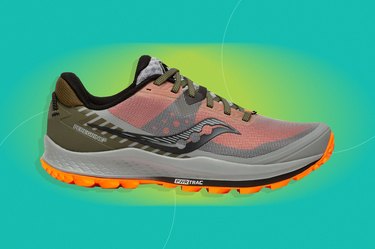
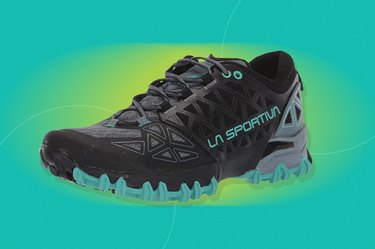
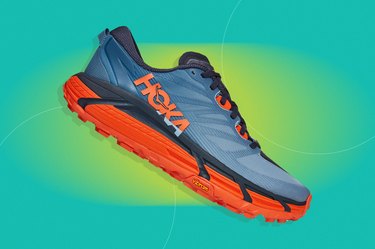
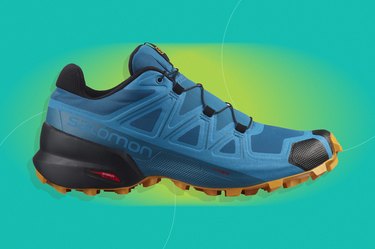
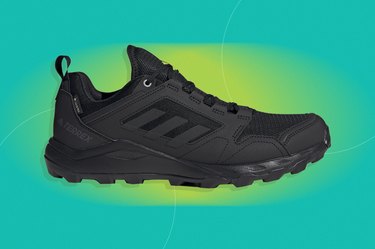
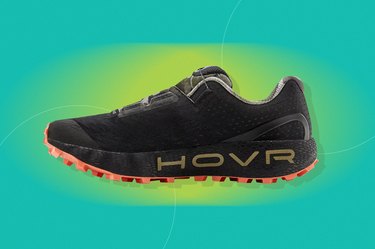
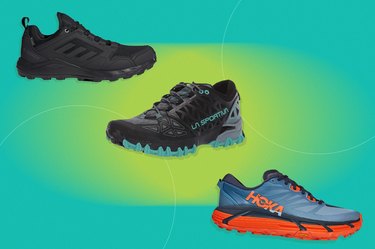

Hitting a trail in standard running shoes isn't as fun as you might imagine. The cushion can feel a little unstable, and the soles can slip on dirt and rocks. But throw on a new pair of trail running shoes, and it's a whole different (read: wonderful) experience.
With so many brands and options out there, though, it's not easy to find a shoe that will take you through your favorite off-road paths while keeping your ankles and feet safe. But look no further: This is your ultimate, expert-approved guide to the best trail running shoes.
Video of the Day
Video of the Day
The Best Trail Running Shoes
- Best Overall: Saucony Peregrine 11 GTX Trail Running Shoe ($104.95, Saucony [men's]; Saucony [women's])
- Best for Speed: La Sportiva Bushido II Running Shoe ($145, La Sportiva [men's]; La Sportiva [women's])
- Best High-Cushion: Hoka Mafate 4 ($185, Hoka [men's]; Hoka [women's])
- Best for Stability: Salomon Speedcross 5 ($130, Salomon [men's]; Salomon [women's])
- Best Waterproof: Adidas Terrex Agravic TR GORE-TEX Trail Running Shoes ($100 [men's], $60 [women's], Adidas [men's]; Adidas [women's])
- Best High-Tech: Under Armour HOVR Machina Off Road Running Shoes ($160, Under Armour [men's]; Under Armour [women's])
How We Chose
With advice from two running experts — one a running coach and the other a physical therapist — we've narrowed your search to guarantee you find the absolute best trail running shoes for men and women.
They offered their product recommendations and helped us break down what to look for in the best trail running shoes. We selected our products based on their criteria, including:
- Shoe shape
- Cushion level
- Ankle movement
- Shoe drop
- Ventilation
Manufacturers typically market shoes according to gender, so we've listed both women's and men's picks below. However, the main difference between most men's and women's shoes lies in the shoe width and size.
In some cases, men's shoes are built to support greater weights. So people with bigger bodies may want to opt for men's versions, whereas people with smaller bodies may prefer women's versions. The choice is up to your preference and comfort.
1. Best Overall: Saucony Peregrine 11 GTX Trail Running Shoe
- Rip-resistant mesh
- Rubber traction on the bottom
- Breathable fabric
A Saucony best-selling shoe, the Peregrine can help you conquer any trail run — rocky trails, dirt paths and unexpected debris don't stand a chance. This shoe has large, rubber ridges on the bottom to provide traction and prevent any slipping or sliding.
And the durable mesh upper can withstand muddy runs, keeping your foot in place when the ground gets unstable, according to Melissa Garcia, DPT, CSCS, a Washington-based physical therapist who treats trail runners and runs trails recreationally herself.
Buy it: Saucony.com (men's); Saucony.com (women's); Price: $104.95
2. Best for Speed: La Sportiva Bushido II Running Shoe
- Supportive heel padding
- Lightweight
- Slip-on design
Garcia highly recommends this seemingly weightless, minimal-cushion trail running shoe for picking up speed. There's just enough traction on the bottom to keep you safe, too. The slip-on design also means you won't have to worry about stopping mid-trek to bend over and tie your shoes.
The cushion on the inner back of these shoes keeps your heel locked in place, making these the best trail running shoes for hiking, too.
Buy it: Sportiva.com (men's); Sportiva.com (women's); Price: $145
3. Best High-Cushion: Hoka Mafate 4
- High cushion level
- Breathable mesh fabric
- Secure tongue that doesn't move
Hoka running shoes are most known for their comfortable cushion, and the company's trail shoes are no exception. The Mafate delivers plenty of padding, and it still has ample flexibility in the forefoot to help you climb trails.
This shoe also sits pretty high above the ground, which is a plus for trail running, according to Jason Fitzgerald, USA Track and Field-certified coach and host of the Strength Running podcast. The higher the shoe sits, the more protection you get from sharp rocks or roots poking into the sole or mesh of the shoe.
4. Best for Stability: Salomon Speedcross 5
- High-traction lugs
- Good for all terrains
- Narrow fit
"The tread on these shoes is no joke," Garcia says.With Salomon's stable trail running shoes, trips and falls are no longer a concern when you hit the trail. This shoe offers plenty of foot protection, thanks to the high-grip bottom and ankle-stabilizing cushion in the heel.
"This is a stable and heavy-duty shoe made for muddy and softer environments," she says.
Buy it: Salomon.com (men's); Salomon.com (women's); Price: $130
5. Best Waterproof: Adidas Terrex Agravic TR GORE-TEX Trail Running Shoes
- Waterproof upper
- Protective cap to prevent toe stubbing
- Durable midsole
Rainy trails have nothing on Adidas' Terrex Agravic trail running shoes. Thanks to their rip-resistant, waterproof GORE-TEX fabric, you don't have to worry about puddles slowing you down as you rack up the miles.
Garcia loves these for their lightweight-but-stable design and dubs them one of the best trail running shoes for women (or those with narrower feet) in particular.
Buy it: Adidas.com (men's); Adidas.com (women's); Price: $100 (men's); $60 (women's)
6. Best High-Tech: Under Armour HOVR Machina Off Road CH1 Runnings Shoes
- App connectivity
- Shock-absorbing cushion
- Ideal for all surfaces
Under Armour's Off Road shoes are as high-tech as an off-road sneaker can get. These can connect to the Under Armour MAPMYRUN app to track and analyze your running metrics, like your mile pace and total distance, according to Garcia.
And if you love hills, the shoe's HOVR cushion technology helps absorb impact, giving your knees a little extra protection. Considering men often have more weight than women, the shock-absorption makes this pair one of the best men's trail running shoes.
Buy it: UnderArmour.com (men's); UnderArmour.com (women's); Price: $160
4 Factors to Consider When Shopping for Your Best Trail Running Shoes
1. Traction
When you run on a trail, your shoes need traction to prevent slips and falls, according to Fitzgerald. So you need to find a pair of shoes that has rubber ridges (aka lugs) on the bottom.
Lugs dig into the dirt and provide resistance, helping you move across uneven ground and gain elevation more confidently, he says. "Just like if you were to drive off-road in your car, running off-road means you need more traction and support."
For dirt paths or trails, you can go with shoes that have less tread, Fitzgerald says. But still look trail shoes with a rubber bottom to get plenty of traction.
The type of lugs on the bottom of the shoe matter, too, according to Garcia. Typically, a wider lug (about a half-inch wide) is best for wet and soft terrain. Lugs that are arranged side-by-side are better for harder, rocky surfaces.
2. Durability
Trekking a trail means you're sure to come in contact with rocks and twigs. Generally, any shoe that's labeled as a trail running shoe will have the durability needed to withstand off-road running, Fitzgerald says.
But if you want extra security, look for a shoe that says it's abrasion-, rip- or snag-resistant. Shoes advertised as being water-resistant (or waterproof) are a plus, too, especially if you run in all sorts of weather.
Also, make sure the shoe's upper is mesh. That keeps things breathable and your feet from overheating.
3. Cushion
The amount of cushion the right trail running shoe has is definitely a matter of personal preference, Garcia says. While some people love the bounce of high-cushioned steps, others prefer to feel the ground beneath their feet.
But you also want to take your terrain into consideration, she says. If most of your outdoor runs are across steep inclines and declines, you may need a shoe with a little more cushion to protect your knees. Extra cushion helps absorb the impact of repetitively pounding your feet on the ground.
For those who tend to run on flatter trails and want a little more speed, a more minimal, lightweight shoe is probably ideal.
Keep the overall shoe height in mind, too, Fitzgerald says. Shoes with more cushion always sit higher above the ground and guard your feet from debris, making them a good choice for less clear-cut paths and trails.
4. Drop
Most running shoes have a heel-to-toe drop. That means the heel has more cushion than the toes, so your foot lowers toward the ground as you move from your heel to your toes. You can find drops anywhere from 0 millimeters (a totally minimal shoe) to 8 millimeters.
A larger drop helps push your foot slightly forward, so people who strike with their heel first may want a higher drop to propel them forward, according to Garcia. Those who strike with the front of their foot won't need as much cushion in the heel to keep moving.
Related Reading